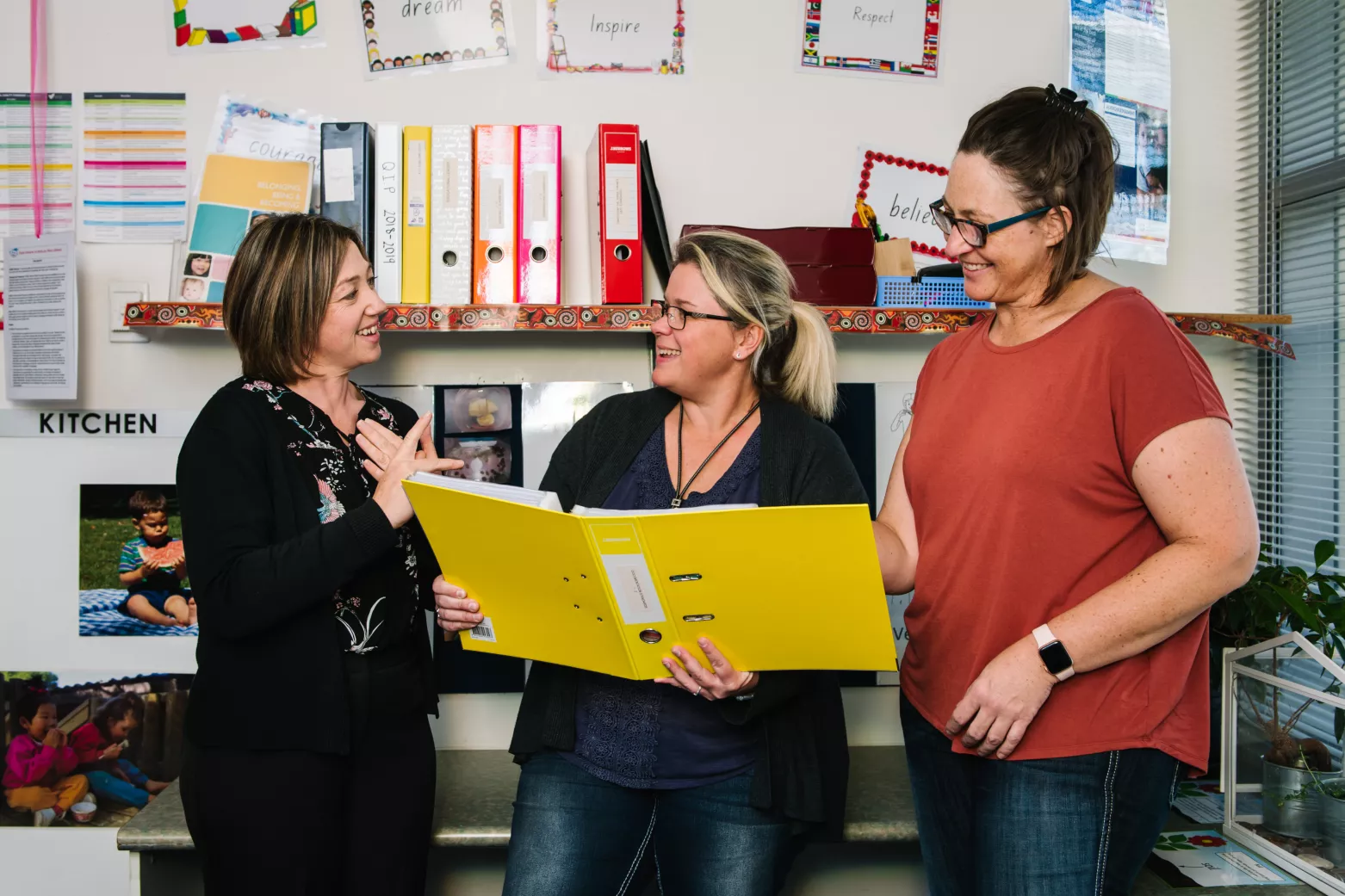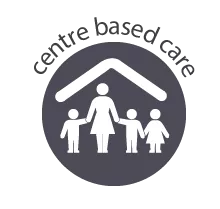Standard 1.3 Assessment and planning – Case study 3
- Home
- Quality ratings
- Exceeding NQS
- Quality Area 1 – Educational program and practice
- Standard 1.3 Assessment and planning – Case study 3
Educators and coordinators take a planned and reflective approach to implementing the program for each child.


This preschool/kindergarten is in an inner-city suburb. The service philosophy highlights the importance of lifelong learning, so the team is committed to actively seeking further opportunities to support best practice in the unique context of their service. The philosophy statement also states that the service is guided by the vision, principles and practices of the approved learning framework, so opportunities to engage in critical reflection are consciously encouraged, individually and together.
The team consistently follows a clear process for gathering and analysing information as part of the assessment and planning cycle, to collect information about what each child knows, can do, and understands. They ensure that the planned educational program and their pedagogical practice responds to children’s strengths, learning dispositions, abilities, ideas and interests, and scaffolds and extends their learning. They critically reflect on and evaluate each child’s progress in relation to the learning outcomes of Belonging, Being & Becoming: The Early Years Learning Framework (EYLF), and identify further opportunities to build on and extend children’s learning, development and wellbeing. They continually consider the circumstances, current and emerging interests, and rights of all children, and question and analyse their practice, honestly and critically, to highlight opportunities for improvement.
One approach they have found particularly useful as a tool for critical reflection and ongoing learning is using an inquiry approach by engaging in action research projects. They first became familiar with this methodology through their involvement in a research project facilitated through their local children’s education and care networking group a few years ago. A key learning from the project was the importance of critical thinking and reflection in program planning, implementation and evaluation. This included having a greater understanding of the difference between evaluation, reflection and critical reflection, the latter requiring a deeper level of questioning, analysis and interrogation. It also strengthened their knowledge, skills and application of critical reflection, individually and as a service team.
What the team found most helpful about the project was that it was undertaken over several months, allowing for a deeper level of understanding, engagement and learning over time. This allowed the team to hypothesize and test out ideas and analyse and question what worked well and what didn’t, to determine what they might continue to do, stop doing or do differently. Another benefit of the project being undertaken over time was that it led to the inquiry approach becoming embedded and sustained in practice, as educators felt increasingly skilled, confident and motivated to use it as a framework for new inquiry topics.
They also enjoyed the opportunity to learn with and gain further knowledge from other educators and services through sharing their different perspectives and insights.
The service team continues to use this approach to reflect on and improve pedagogical practice and finds it most helpful when critically reflecting on shared issues, challenges and questions. A recent action research project undertaken at the service was inspired by a team discussion of the ‘100 Languages’ by Loris Malaguzzi, whose thinking inspired the principles and practices of the preschools and infant-toddler centres of the municipality of Reggio Emilia. The research question that resulted from the discussion was, ‘How does the organisation of learning spaces and materials enable children to communicate their thinking and learning in different ways?’ One educator, who is passionate about the visual arts, focused on the service’s art space, ensuring that children were offered a range of quality, sustainable materials, and that materials were presented in a way that was appealing, engaging and stimulated children’s curiosity.
Afterwards, the team shared their critical reflections about how the children had interacted with materials in the art space. One educator had observed the children engaging with the materials in ways they hadn’t expected or anticipated. Another educator agreed and shared their thinking and learning during the action research project. This included their initial hesitancy about moving away from what they termed ‘craft’, as they didn’t see themselves as being ‘artistic’, a sentiment shared by some of the other educators.
Educators reflected on why they might be feeling this way. They shared that they initially lacked the knowledge and confidence to support the children in directing their own art experiences. Through exploring their thoughts and feelings in this way, they were then able to consider how this might be impacting resources and experiences offered to children. After reviewing and analysing information collected through the project, they could also see the benefit of offering open-ended art experiences that enabled children to demonstrate their capability and competence and communicate their ideas in different ways.
Educators commented that what they had noticed were the subjects of the children’s art, as well as their conversations while they engaged with the art materials. The main topic of conversation in the art space at that time was COVID-19. This began when one child drew their interpretation of the coronavirus, which prompted many others to follow suit. Educators engaged in discussions about if and how they might extend on this experience. They also sent copies of photos and their initial reflections and questions to families to draw on their knowledge, insights and perspectives to inform decision-making, program planning and implementation.
Educators noticed that some of the children’s drawings seemed more menacing than others, with the coronavirus depicted in black, with sharp teeth and an indignant expression. Other children used a range of colours for their drawings, with the coronavirus beaming from the page. In analysing these observations and reviewing transcripts from their conversations with children and feedback obtained from families, it was evident that children were using art to make sense of what was happening around them, as a mechanism to express their ideas, thoughts and feelings.
The team reflected on if and how they might extend on this and further explore the children’s experiences, knowledge and responses to COVID-19. They also reflected on their conversations with families who chose to keep their children at home during COVID-19 lockdowns, where educators remained connected with children and families online. In some cases, families shared their own apprehensions about COVID-19, noting that this was an unsettling time for everyone.
In addition to communicating with families about the educational program, the service team was committed to actively ensuring that families were kept well informed about how COVID-19 was influencing children’s play and participation in the program, as well as how educators were responding to children’s play. If families were observing their child’s play at home being influenced by COVID-19 and were not sure how to respond or support them, the team provided them with access to further information and support.
One family, for example, was concerned their child had become anxious about leaving home during lockdown. Together, the family and educators talked about what they were noticing in the child’s behaviour at home and at the service, and how they might better understand this. They also discussed what strategies and experiences they might provide for the child to acknowledge their feelings and provide reassurance. For the service, this included maintaining a consistent and predictable routine and including experiences that they knew were interesting and engaging for the child in the program. They also maintained close communication with the family to determine the effectiveness of these strategies and inform ongoing planning for the child.
During further team discussions, one educator suggested the possibility of engaging with children and families on a project to explore what was different and what was the same during COVID-19. To inform subsequent discussions, the educational leader sourced an article about the potential of art to help children express their thoughts and feelings, and another article about talking to children about sensitive topics, such as COVID-19. These were shared for everyone to read before the next team meeting.
The team discussed their responses to the articles and used a curriculum decision-making map they had developed to guide their thinking, analyse children’s learning, and design and plan next steps. This included thinking about the organisation of time, space, and materials to engage children and explore links to the learning outcomes of the approved learning framework. Educators also considered how they would introduce the project to families, keep them informed, and seek out their insights and perspectives. As with any other aspect of their child’s learning, development and wellbeing, families’ ideas and perspectives about the project were considered as part of the ongoing assessment and planning for their child.
Over several weeks, educators encouraged children to express their ideas and responses through art, and consistently responded to questions that arose. With the children’s permission, they also recorded some of their conversations to document their thinking and learning and revisit these with the children over time. Educators noted that the children’s artwork and conversations about their work showed that each child’s understanding and experience of COVID-19 was different.
Some children drew pictures of their local parks and talked about how the swings had been removed, which they said made them sad. Others drew pictures of their friends and talked about how they missed not being able to play with them but could still see them on FaceTime. Another child, whose parent was a doctor, drew the coronavirus sleeping in a hospital bed.
* To create a print friendly version of this case study, please click ‘print’ in the red menu bar.